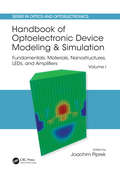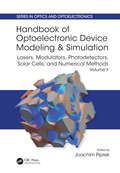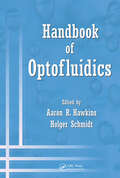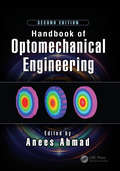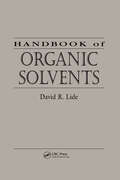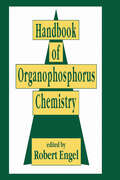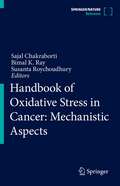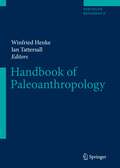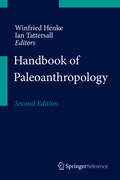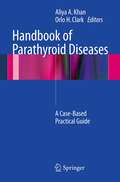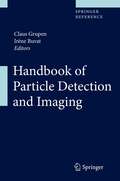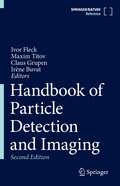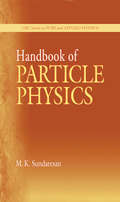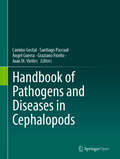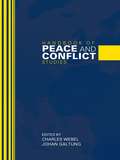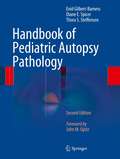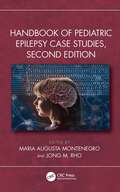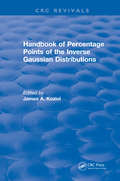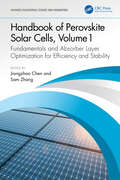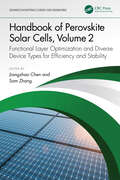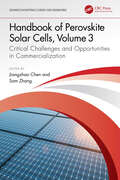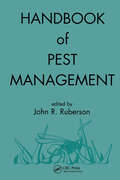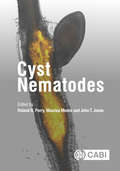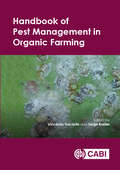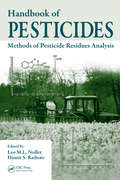- Table View
- List View
Handbook of Optoelectronic Device Modeling and Simulation: Fundamentals, Materials, Nanostructures, LEDs, and Amplifiers, Vol. 1 (Series in Optics and Optoelectronics)
by Joachim PiprekOptoelectronic devices are now ubiquitous in our daily lives, from light emitting diodes (LEDs) in many household appliances to solar cells for energy. This handbook shows how we can probe the underlying and highly complex physical processes using modern mathematical models and numerical simulation for optoelectronic device design, analysis, and performance optimization. It reflects the wide availability of powerful computers and advanced commercial software, which have opened the door for non-specialists to perform sophisticated modeling and simulation tasks. The chapters comprise the know-how of more than a hundred experts from all over the world. The handbook is an ideal starting point for beginners but also gives experienced researchers the opportunity to renew and broaden their knowledge in this expanding field.
Handbook of Optoelectronic Device Modeling and Simulation: Lasers, Modulators, Photodetectors, Solar Cells, and Numerical Methods, Vol. 2 (Series in Optics and Optoelectronics)
by Joachim PiprekOptoelectronic devices are now ubiquitous in our daily lives, from light emitting diodes (LEDs) in many household appliances to solar cells for energy. This handbook shows how we can probe the underlying and highly complex physical processes using modern mathematical models and numerical simulation for optoelectronic device design, analysis, and performance optimization. It reflects the wide availability of powerful computers and advanced commercial software, which have opened the door for non-specialists to perform sophisticated modeling and simulation tasks. The chapters comprise the know-how of more than a hundred experts from all over the world. The handbook is an ideal starting point for beginners but also gives experienced researchers the opportunity to renew and broaden their knowledge in this expanding field.
Handbook of Optofluidics
by Holger Schmidt Haron R. HawkinsOptofluidics is an emerging field that involves the use of fluids to modify optical properties and the use of optical devices to detect flowing media. Ultimately, its value is highly dependent on the successful integration of photonic integrated circuits with microfluidic or nanofluidic systems. Handbook of Optofluidics provides a snapshot of the s
Handbook of Optomechanical Engineering (Optical Sciences and Applications of Light)
by Anees AhmadThis comprehensive handbook covers all major aspects of optomechanical engineering - from conceptual design to fabrication and integration of complex optical systems. The practical information within is ideal for optical and optomechanical engineers and scientists involved in the design, development and integration of modern optical systems for commercial, space, and military applications. Charts, tables, figures, and photos augment this already impressive text. Fully revised, the new edition includes 4 new chapters: Plastic optics, Optomechanical tolerancing and error budgets, Analysis and design of flexures, and Optomechanical constraint equations.
Handbook of Organic Solvents
by David R. LideThis invaluable handbook presents important information on over 500 organic compounds that are used as solvents. Health hazards and safety guidelines are discussed, including the limiting values for airborne exposure, carcinogenicity status, and various official hazard ratings. This handy reference contains many useful data fields, such as:
Handbook of Organophosphorus Chemistry
by Robert EngelThis practical work summarizes the development of organophosphorus chemistry in topical areas and details the discipline's current state - providing applications and experimental procedures throughout.;Written by 18 leading authorities in the field, the Handbook of Organophosphorus Chemistry: examines advances in the mechanistic understanding of the Perkow and related organophosphorus reactions; describes methods for the reduction of quinquevalent to trivalent phosphorus and their applications to standard synthetic procedures; emphasizes the preparation of phosphonates bearing hydroxy, amino, and thiol functions at the alpha-position relative to the phosphoryl group; reviews the basics of NMR as it applies to the 31P nucleus, considering the use of the latest measurement techniques in solving structural and mechanistic problems; compares the characteristics of polymer-based and monomeric materials; and presents recent progress in the design of insecticides and covers their chemical and biological characteristics.;Generously referenced with close to 3000 bibliographic citations, the Handbook of Organophosphorus Chemistry is an important volume for organic, medicinal, and agricultural chemists and biochemists; pharmacists; chemical engineers; and graduate-level students in these disciplines.
Handbook of Oxidative Stress in Cancer: Mechanistic Aspects
by Sajal Chakraborti Bimal K. Ray Susanta RoychoudhuryThis comprehensive, up-to-date reference work compiles the scientific research on the relationship between various forms of cancer and reactive oxygen species (ROS). It is well known that ROS play a key role in the various steps leading to malignancy, this includes increase in DNA mutation rates. The book brings together exciting reviews, written by leading experts all over the world. The book is divided into four broad sections. Each section describes the role of oxidative stress and underlying mechanisms and pathways, at various stages of cancer, including its role in carcinogenesis, cancer progression and metastasis. Further, the book describes how the reactive oxygen species (ROS) modulate gene expression and signal transduction pathways in cancer. The book discusses the ways to interfere with the cancer progression, and design of anti-cancer drugs. The book provides an integrated approach for better understanding of the development phases of oxidative stress-induced cancers, and mainly the current perspectives about mechanistic aspects of cancer initiation, progression and metastasis. It is a highly resourceful book and would be extremely important to clinicians, students and researchers in the field of cancer genetics, therapeutics and oncology.
Handbook of Paleoanthropology
by Ian Tattersall Winfried Henke T. HardtThis 3-volume handbook brings together contributions by the world´s leading specialists that reflect the broad spectrum of modern palaeoanthropology, thus presenting an indispensable resource for professionals and students alike. Vol. 1 reviews principles, methods, and approaches, recounting recent advances and state-of-the-art knowledge in phylogenetic analysis, palaeoecology and evolutionary theory and philosophy. Vol. 2 examines primate origins, evolution, behaviour, and adaptive variety, emphasizing integration of fossil data with contemporary knowledge of the behaviour and ecology of living primates in natural environments. Vol. 3 deals with fossil and molecular evidence for the evolution of Homo sapiens and its fossil relatives.
Handbook of Paleoanthropology
by Ian Tattersall Winfried HenkeThis extensive, three-volume handbook, intensively updated and enlarged, is a superb new resource for students, researchers, and practitioners in paleoanthropology. A baseline storehouse covering the full extent of current knowledge, the volume features an online e-reference work that will be updated with future developments in this fascinating discipline. Often cited as the most multidisciplinary of all the sciences, paleoanthropology encompasses a vast range of techniques drawn from geology, evolutionary biology, and archaeology, among many others. Guided by an editorial team of global stature, the contributions reflect the best of today's scholarship. Each volume covers core constituents of the subject: basic principles and methods, primate evolution and human origins, and the phylogeny of hominins. The editors have ensured that the entries uphold a key principle of paleoanthropology, requiring historical assessments to be updated with developing knowledge of the living world. The handbook's first volume incorporates the enormous advances made in such areas as phylogenetic analysis, paleoecology and evolutionary theory and philosophy. Volume II integrates primate fossil data with the vast amount that is now known of the behavior and ecology of living primates in natural environments. The third volume deals with the fossil and molecular evidence for the evolution of Homo sapiens and its fossil relatives. Paleoanthropology is characterized by its many live and unresolved academic debates, which are reflected in the heterogeneity of intellectual standpoints in this handbook. This planned diversity ensures that the Springer Handbook of Paleoanthropology is a multilayered, comprehensive companion of inestimable value to students, academics, and working professionals alike.
Handbook of Parathyroid Diseases
by Orlo H Clark Aliya A. KhanThe Handbook on Parathyroid Diseases presents a comprehensive and concise overview of our current knowledge in the area of parathyroid function, hormone regulation and disease states. The Handbook educates the reader using a case-based approach presenting current evidence in the field. The material is presented in an easy to read and understandable language and uses a plethora of tables and text boxes where possible. Complex concepts are conveyed in simple and clear language. Leading international experts contribute to this state of the art book providing a true depth of knowledge and practicality.
Handbook of Particle Detection and Imaging
by Claus Grupen Irène BuvatThe handbook centers on detection techniques in the field of particle physics, medical imaging and related subjects. It is structured into three parts. The first one is dealing with basic ideas of particle detectors, followed by applications of these devices in high energy physics and other fields. In the last part the large field of medical imaging using similar detection techniques is described. The different chapters of the book are written by world experts in their field. Clear instructions on the detection techniques and principles in terms of relevant operation parameters for scientists and graduate students are given.Detailed tables and diagrams will make this a very useful handbook for the application of these techniques in many different fields like physics, medicine, biology and other areas of natural science.
Handbook of Particle Detection and Imaging
by Claus Grupen Irène Buvat Ivor Fleck Maxim TitovThis handbook covers the fundamental principles of interactions of particles with matter and of most types of detectors used in many fields of physics, starting from particle physics, nuclear physics up to recent experiments for solid state physics. In this second edition chapters are updated to include the most recent developments in detector physics and additional chapters on new types of detectors, like silicon photomultipliers, have been added. In addition the section about medical applications has been extended. All major detector types are described in detail by leading experts in these fields. It also gives deep insight into many applications from homeland security over radiation protection to a whole section about medical physics with strong emphasis on nuclear medicine. The book is suited to achieve a deep knowledge in the field of detector physics and imaging. It can also be used as a reference book to look up the working principles of a given detector type and to get an overview of state-of-the-art applications of the various detector types. It is also helpful for practitioners in nuclear medicine and radiology as it summarizes all detector types in this field and the basic working principles of these detectors. The area of radiation therapy is also covered in detail taking into account the most recent developments.
Handbook of Particle Physics (Pure and Applied Physics)
by M.K. SundaresanLiterally thousands of elementary particles have been discovered over the last 50 years, their properties measured, relationships systematized, and existence and behavior explained in a myriad of cleverly constructed theories. As the field has grown so impressively, so has its jargon. Until now, scientists in other fields have had no single resource from which they can quickly reference an idea, acronym, or term and find an accessible definition and explanation.The Handbook of Particle Physics fills that void. This unique work contains, in encyclopedic form, terms of interest in particle physics, including its peculiar jargon. It covers the experimental and theoretical techniques of particle physics along with terms from the closely related fields of astrophysics and cosmology. Designed primarily for non-specialists with a basic knowledge of quantum mechanics and relativity, the entries preserve a degree of rigor by providing the relevant technical and mathematical details.Clear and engaging prose, numerous figures, and historical overviews complement the handbook's convenience both as a reference and as an invitation into the fascinating world of particle physics.
Handbook of Pathogens and Diseases in Cephalopods
by Camino Gestal Santiago Pascual Ángel Guerra Graziano Fiorito Juan M. VieitesThe aim of this open access book is to facilitate the identification and description of the different organs as well as pathogens and diseases affecting the most representative species of cephalopods focussed on Sepia officinalis, Loligo vulgaris and Octopus vulgaris. These species are valuable ‘morphotype’ models and belong to the taxonomic groups Sepioidea, Myopsida and Octopoda, which include most of the species with a high market value and aquaculture potential. The study is based on photographs at macroscopic and histological level in order to illustrate the role of the most important pathogens and related diseases from the view of a pathological diagnosis. The reader is able to familiarize with functional anatomy, necropsy and general histology of adults and paralarvae, as well as with the identification of different pathogens and pathologies. This work is thus an invaluable guide for the diagnosis of cephalopod diseases. Besides including pathogens for non-European cephalopod species, it also provides a useful contribution encouraging marine pathologists, parasitologists, veterinarians and those involved in fishery sanitary assessments, aquarium maintenance and aquaculture practices aiming to increase their knowledge about the pathology of cephalopods.
Handbook of Peace and Conflict Studies (Weber in Translation)
by Johan Galtung Charles WebelThis major new Handbook provides a cutting-edge and transdisciplinary overview of the main issues, debates, state-of-the-art methods, and key concepts in peace and conflict studies today. The fields of peace and conflict studies have grown exponentially since being initiated by Professor Johan Galtung half a century ago. They have forged a transdisciplinary and professional identity distinct from security studies, political science, and international relations. The volume is divided into four sections: understanding and transforming conflict creating peace supporting peace peace across the disciplines. Each section features new essays by distinguished international scholars and professionals working in peace studies and conflict resolution and transformation. Drawing from a wide range of theoretical, methodological, and political positions, the editors and contributors offer topical and enduring approaches to peace and conflict studies. The Handbook of Peace and Conflict Studies will be essential reading for students of peace studies, conflict studies and conflict resolution. It will also be of interest and use to practitioners in conflict resolution and NGOs, as well as policy makers and diplomats.
Handbook of Pediatric Autopsy Pathology
by Diane E. Spicer Enid Gilbert-Barness Thora S. SteffensenPathologists have long recognized that pediatric autopsy requires great care in technique and dissection to ensure that easily overlooked malformations are recognized and accurate diagnoses are made. The highly experienced authors have created a new edition of Handbook of Pediatric Autopsy Pathology, a comprehensive reference guide to the actual performance of the pediatric autopsy and the optimal recognition and interpretation of pathologic findings. The Handbook of Pediatric Autopsy Pathology, Second Edition covers the spectrum of pediatric pathology with particular reference to those conditions that can be identified at autopsy. New and updated material includes microbiological studies, particularly with the advent of newly described micro-organisms causing disease. The volume also addresses new developments in metabolic diseases, new techniques of ultrasound imaging, and specialized laboratory testing. Furthermore, the book provides a wealth of practical information and bibliographic citations throughout, new copious illustrations and line drawings, numerous standard reference tables, and appendices at the end of multiple chapters. Authored by authorities in the field, Handbook of Pediatric Autopsy Pathology, Second Edition is a valuable resource that will assist general and pediatric pathologists, neonatologists, interns and residents in training, as well as specialists in cytogenetics and ultrasound technicians in understanding the manner and cause of death in its broadest and comprehensive sense.
Handbook of Pediatric Epilepsy Case Studies, Second Edition
by Jong M. Rho Maria Augusta MontenegroResearch in the field of epilepsy will continue at a rapid pace, with the ultimate hope of curing many intractable epilepsy syndromes. Fully updated, this new edition is organized chronologically, from neonate through adolescence, and the handbook is the culmination of a group effort involving leading physicians and researchers whose contributions constitute a concise and practical reference for health professionals in training. Here the contributors review the recent flood of new information on the pathophysiology, genetics, and treatment of the various epilepsy syndromes, and the volume is distilled into an easy-to-use guide. Fully updated text reviewing the latest research on the pathophysiology, genetics, and treatment of the various epilepsy syndromes. Thorough descriptions of the different syndromes commonly encountered in clinical practice across the pediatric range. Extensive resource section provided. Contributors describe why they chose each particular case, what they learned, and how it changed their practice. The book includes the most recent classification and nomenclature published by the International League Against Epilepsy.
Handbook of Percentage Points of the Inverse Gaussian Distributions
by James A. KoziolThe purpose of this handbook is to provide comprehensive tables of percentage points of the inverse Gaussian distribution. There is no other publication available today which condenses these tables - to such extent-in a concise, straightforward manner. The inverse Gaussian distribution is not only important for determining boundary crossing probabilities of Brownian Motion, which probabilities determine the operating characteristics of many sequential sampling procedures in statistics. It is also used in quality control procedures. This one-of-a-kind work includes a brief introductory section which outlines the inverse Gaussian distribution and explains the tables. The tables are produced in a fine grid of cumulative probabilities, and uses the closed form expression for the cumulative distribution function. This easy-to-use table reference also includes an excellent discussion of searching ordered tables. This handbook is a helpful, indispensable guide for all who are involved with statistics, mathematics, and computers. Mechanical engineers and physicists will find it useful also.
Handbook of Perovskite Solar Cells, Volume 1: Fundamentals and Absorber Layer Optimization for Efficiency and Stability (ISSN)
by Sam Zhang Jiangzhao ChenOrganic–inorganic hybrid metal halide perovskite materials have attracted significant attention due to their advantages of low cost, tunable band gap, solution processing, high molar extinction coefficient, low exciton binding energy, and high carrier mobility. Perovskite absorber layers play a decisive role in the realization of high-power conversion efficiency in perovskite solar cells (PSCs). This book systematically and comprehensively discusses device structures, working principles, and optimization strategies of perovskite absorber layers for PSCs to help foster commercialization of these environmentally friendly power sources. It describes strategies to optimize the quality of perovskite films, including composition engineering, dimensional engineering, solvent engineering, strain engineering, additive engineering, and interface engineering.This volume: Introduces crystal structures of perovskites, configurations of PSCs, and their working principles Discusses the modulation of perovskite compositions and dimensionality towards highly stable and efficient perovskite photovoltaics Details the advancements of low-dimensional PSCs including phase stability of perovskite films and strategies for modulating phases Summarizes progress in solvent engineering, additive engineering, and strain engineering in efficient and scalable perovskite photovoltaics Describes the complex crystallization dynamics of perovskites, interface engineering, and synergistic modulation of grain boundaries and interfaces in PSCs Highlights advances in ion migration and mitigation in halide perovskite solar cells and origins and elimination of hysteresis This book is aimed at researchers, advanced students, and industry professionals in materials, energy, and related areas of engineering who are interested in development and commercialization of photovoltaic technologies.
Handbook of Perovskite Solar Cells, Volume 2: Functional Layer Optimization and Diverse Device Types for Efficiency and Stability (ISSN)
by Sam Zhang Jiangzhao ChenPerovskite solar cells (PSCs) have received significant attention in academia and industry due to their low cost and high-power conversion efficiency (PCE). Single- and multijunction PSCs have obtained promising certified PCEs, which suggests that PSCs are a very promising next-generation photovoltaic technology. In addition to the perovskite absorber layer, other functional layers, including electron transport layer (ETL), hole transport layer (HTL), and electrode layer (EL), have also made huge contributions to enhancing device performance. This book focuses on the development, advancement, and application of these functional layers in various PSCs.This volume: Introduces ETL, HTL, and EL in efficient and stable PSCs. Covers material properties. Discusses a wide variety of PSCs including single-crystal PSCs, flexible PSCs, perovskite tandem solar cells, lead-free PSCs, inorganic PSCs, fully printable mesoscopic PSCs, electron/hole-transport-layer-free PSCs, semitransparent PSCs for building-integrated photovoltaics (BIPV), tandem solar cells, perovskite indoor photovoltaics, and inverted PSCs. Details potential for commercial application. This book is aimed at researchers, advanced students, and industry professionals in materials, energy, and related areas of engineering who are interested in development and commercialization of photovoltaic technologies.
Handbook of Perovskite Solar Cells, Volume 3: Critical Challenges and Opportunities in Commercialization (ISSN)
by Sam Zhang Jiangzhao ChenPerovskite solar cells (PSCs) have emerged as one of the most promising new solar cells, with strong commercial potential. Several challenges remain before PSCs can be released in wide-scale commercial application. This book highlights the opportunities, advancements, and critical challenges involved in the commercial application of PSCs. It discusses large area fabrication, long-term stability, lead management, encapsulation techniques, as well as a commercial roadmap and current and future trends.This volume: Details the importance of lead management strategies to minimize toxicity. Shares progress on photon management. Discusses advances and challenges in enlarging perovskite use and the key factors restraining upscaling. Highlights issues around long-term stability of PSCs. Summarizes commercial advances around the industrialization of PSCs. This book is aimed at researchers, advanced students, and industry professionals in materials, energy, and related areas of engineering who are interested in development and commercialization of photovoltaic technologies.
Handbook of Pest Management
by John R. Ruberson"Provides a detailed summary of pest management principles and techniques, outlining a broad selection of critical issues regarding current practice and future technology in this area. Discusses the role of soils, weather, and surrounding habitats in regulating pest occurrence and severity."
Handbook of Pest Management in Organic Farming
by Capacity Building for Sustainable Development Valentine JamesThis book is a compendium of current information on all aspects of these economically important parasites. It provides comprehensive coverage of their biology, management, morphology and diagnostics, in addition to up-to-date information on molecular aspects of taxonomy, host-parasitic relationships and resistance. Written by a team of international experts, Cyst Nematodes will be invaluable to all researchers, lecturers and students in nematology, parasitology, agriculture and agronomy, industries with an interest in chemical and biological control products for management of plant-parasitic nematodes, and any courses, quarantine and advisory services.
Handbook of Pest Management in Organic Farming (CABI Plant Protection Series)
by Jorge Peña Raija Komppula Beate Bursta Urs Niggli Massimo Benuzzi Gavino Delrio B. Merle Shepard Hüseyin Baspinar Carmelo Bonsignore Dominique Bordat Qiang Xiao Bernard Dufour Régis Babin Alberto Pantoja Josep Anton Jacas MiretThis book is an up-to-date and comprehensive reference covering pest management in organic farming in major crops of the world. General introductory chapters explore the management of crops to prevent pest outbreaks, plant protection tools in organic farming, and natural enemies and pest control. The remaining chapters are crop-based and discuss geographic distribution, economic importance and key pests. For each pest the fundamental aspects of its bio-ecology and the various methods of control are presented. Understanding of the scientific content is facilitated with practical advice, tables and diagrams, helping users to apply the theories and recommendations. Handbook of Pest Management in Organic Farming: · Consists of rational approaches and advice. · Is authored by a team of international specialists in pest control. · Represents the only available comprehensive review of insect pest management in organic systems. This is an essential resource for researchers and extension workers in crop protection, integrated pest management and biocontrol, and organic farming systems.
Handbook of Pesticides: Methods of Pesticide Residues Analysis
by Hamir Singh Rathore Leo M.L. NolletThis handbook provides a systematic description of the principles, procedures, and technology of the modern analytical techniques used in the detection, extraction, clean up, and determination of pesticide residues present in the environment. This book provides the historical background of pesticides and emerging trends in pesticide regulation. The
